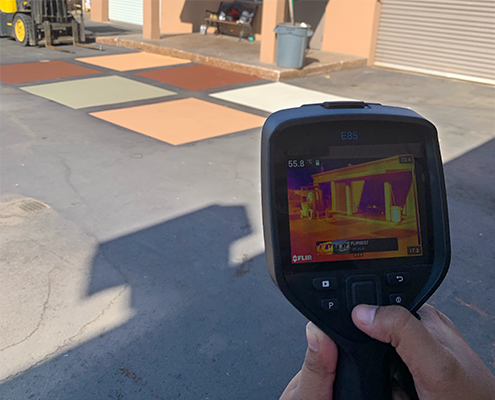More Nuance Is Needed to Accurately Measure Extreme Heat in Cities
A research team led by V. Kelly Turner calls for more comprehensive urban heat data — an essential element of any strategy to cool cities down

A thermal imaging camera captures temperature variations of cool paints. Photo credit: Ariane Middel.
January 11, 2022
Policymakers are working to cool cities down and protect residents from viciously hot temperatures. But many common tactics to manage heat — such as “cool” surfaces designed to reflect heat rather than absorb it and get hotter — are based on limited data that masks the real conditions people experience. A new study finds that designing cooler cities will require a different type of temperature data than what most cities have at their disposal.
The most readily available maps of heat in cities tend to report land surface temperatures — essentially, the skin temperature of the earth. But this measurement does not necessarily represent the actual conditions people experience: air temperature, humidity, heat radiated by pavement and other objects, and shade all contribute to how warm you may feel. For example, you will likely feel hotter standing on an unshaded asphalt road than under the shade of a tree. This study shows that measuring surface temperature alone does not capture the effects of these factors.
The study authors call for more holistic heat measurement in cities, asserting that more comprehensive data is necessary to understand the best strategies for managing urban heat. In addition to working to make more extensive data available, the researchers recommend improving climate literacy among policymakers and planners so that cities understand the limitations of current data, the many different facets of urban heat, and the trade-offs of addressing different heat-related goals.
To learn more, read “More Than Surface Temperature: Mitigating Thermal Exposure in Hyper-local Land System,” coauthored by Luskin Center for Innovation co-director V. Kelly Turner and researchers Morgan Rogers and John “Jake” Dialesandro; UCLA geography researcher Jonathan Ocón; and Arizona State University researchers Yujia Zhang, Ariane Middel, Florian Schneider and Megs Seeley. Funded by the Luskin Center for Innovation, the study was published in the “Women in Land Science” issue of the Journal of Land Use Science.


